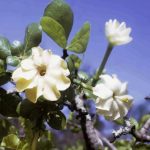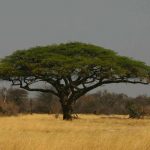TREE LIFE
September 1986
MASHONALAND CALENDAR
Tuesday September 2nd : Botanic Garden Walk Meet in the car park at 1645 for 1700 hours.
Sunday September 21st : Usasa Farm, Chegutu. After the most successful visit to Tom and Nora Brierley’s farm with the Chegutu folk last month, we are very keen to let more of you see it. For more details see Meg’s write up in this newsletter. We propose to have lunch at the Brierleys and then spend the afternoon at the Serui River. A bus has been organized to leave Monomatapa Car Park at 0815 hours. Fare $15.00.
USASA FARM, CHEGUTU – SUNDAY 3RD AUGUST 1986
When I visit Chegutu I think I always do so with a sense of anticipation, and I don’t mean only for the very warm welcome and the tea, also welcome, which seem to await us, but, because we always seem to find something exciting. Our trip on the first Sunday in August was no exception.
The sun was pleasantly warm and, as to be expected in August, the grass was dry and many trees were leafless, but we found lots to interest us as we wandered through a piece of uncut woodland preserved with love by Tom and Nora Brierly. There were many Cassine matabelica, condiment Cassine, with both opposite and alternate leaves, a feature which it shares with Catha edulis, Bushman’s Tea, a member of the same family CELASTRACEAE, as is the Maytenus genus. We discussed how Maytenus heterophylla, the spike thorn, has green leaves with margins which have fine even teeth or no teeth at all while Maytenus senegalensis, the Confetti tree, has much bluer leaves with pink midribs and petioles and margins which are irregularly scalloped, and we wondered how we could have been stupid enough to confuse the two.
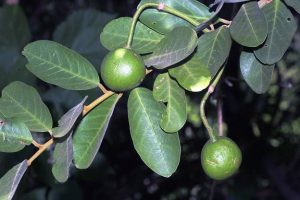
Capparis tomentosa. Photo: Bart Wursten. Source: Flora of Zimbabwe
Gardenia ternifolia was not in fruit but had the distinctive bark which looked as though it would part with some powder when rubbed even though on some occasions all the powder appeared to have been rubbed off. Perhaps Powder bark Gardenia would be a better name than Large leaved Gardenia. Capparis tomentosa, wooly caper bush, provided a point of interest with an old fruit exhibiting its long stalk called a “gnophore”. Kim explained to us that most flowers have the ovary at the base of the flower so that the fruit develops on the end of the flower or fruit stalk called the “pedicel”; C.tomentosa has the ovary at the end of a long tube called a “gynophores” which sticks out above the central mass of stamens and so when the fruit develops the gynophore does too. There was a small Boscia salicifolia, willow leaved Boscia, and the Chegutu folks were able to confirm the identification of the one they had seen on their previous outing.
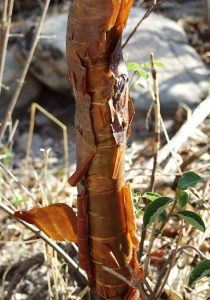
Euphorbia espinosa. Photo: Rob Burrett.. Source: Flora of Zimbabwe
And so we wandered on enjoying the warmth and the bush. Kim found a piece of red jasper and then some more and we turned our attention to the ground and because that was where we were looking we spotted a very small “find of the day” Haplocoelum foliolosum. This is a member of the SAPINDACEAE family and “foliose” means with many leaves. It has pinnate, once compound leaves with 3 – 14 opposite leaflets which are so asymmetric that the midrib appears to run diagonally across the leaflet instead of down the centre. This is something Kim has seen once before and I have seen twice, the last time at Stanley Farm with Brian Watkins, and so we were very excited to see it again. Our excitement mounted as we found a bigger specimen and then realized that the big trees which formed the canopy were all Haploceolum and the rocks underneath were all japer. And believe it or not, amongst the rocks was lots of Maerua friesii which, when we found it at Stanley Farm, had only been collected once before in this country. Other things of interest on that little rocky outcrop are Hippocratea, probably, parvifolia and Euphorbia espinosa, a leafy Euphorbia with a flaking bark.
What a place, and since this was written it has been decided that that is where we will go for our September outing and by then the buds on Maerua friesii may well be open.
-Meg Coates Palgrave
ROOTNOTE FOR CHEGUTU WRITE UP
We ere all so excited at having found Haploceolum foliosum and Maerua friesii on the Brierley’s farm last month we forgot to ask the Chegutu folk how far we were from the Watkin’s farm where we last found these two species. The answer may have been about 4km to the north-est. It just shows how confusing all the bends in the road really are. The second point I discovered by examining the “Geological Map of the Eastern Part of the Hartley Gold Belt” 1952, in the area there are a number of snake like intrusions of banded ironstone and jasperlite. Besides the one on the Brierley’s farm, another band ends with the hill directly behind the Watkins farmhouse, exactly where we found these species last time! These bands seem to resist weathering more than the surrounding rock and thus stand out as ridges. Another interesting area worth further investigation is the serpentine intrusion that runs through the Watkin’s farm, all of which emphasizes the importance of taking a geological map along with us each time.
-Kim ST.J.Damstra
MATABELELAND CALENDAR
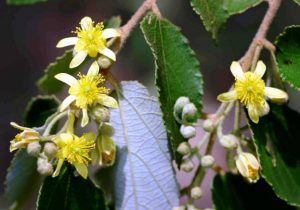
Grewia monticola. Photo: Bart Wursten. Source: Flora of Zimbabwe
Sunday September 7th : Lower Umgusa Dam. Meet at Falls Road Motors at 0830 hours but arrange cars beforehand.
On Sunday August 3rd we went to an area along the Jo’burg Road, just beyond the Harry Allen Golf Club, in fact, just opposite the former Centenary City site. We identified some 45 trees, rather different from most areas immediately round Bulawayo, perhaps due to a good deal of ironstone in the area. Owing to the late rains there were over many grass seeds.
We found Acacia gerrardii, Acacia karroo, Acacia nilotica and A.robusta, some Albizia amara with very long pods, Azanza garckeana without the usual mid rib gland, Carissa edulis and Carissa bispinosa, Cassine transvalensis fruiting heavily and with leaves somewhat fascicled, Clerodendron glabrum, Combretum apiculatum, Combretum hereroense, Combretum molle, what seemed to be Commiphora africana, Commiphora schimperi but being leafless, it was difficult to be sure, another unidentified Commiphora, Dichrostachys cinerea, Diospyros lycioides, Ehretia rigida, Euclea divinorum, Gardenia volkensii, Grewia flavescens, Grewia flava, Grewia monticola, Heteromorpha trifoliate, clearly one of the Parsley Family, Lannea discolor, Lonchocarpus capassa, Maytenus heterophylla fruiting well, Mundulea sericea browned with frost or rather cold, Ormocarpus trichocarpum, Pappea capensis, Peltophorum africanum, Rhus lancea, Rhus tenuinervis, Schrebera alata fruiting, Sclerocarya birrea nearly leafless, Securinega virosa, Tarchocanthus camphorates also much affected by the cold, Ximenia americana, Zanthoxylum capense and also Zanthoxylum chalybeum which most of us had not seen before and which had very knobby stems, Ziziphus mucronata.
The other side of the road were some exotic trees, including Ficus religiosa, the Paepul tree or Bo Tree, also new to some of us. Another interesting tree of which we saw several was Scolopia zeyheri.
-C.Sykes
BOTANIC GARDEN WALK – 2ND AUGUST 1986 ACACIAS RE-VISITED AGAIN
As the Haxen brats were unusually trying and with social pressures running high I am most grateful to Marjorie for taking over the notes. The following comments combine her notes with mine as well as reference to Ross, J.H. 1979. A conspectus of the African Acacia Species. Mem.Bot.Surv.S.A. 44 : 1-155.
Tom began in the South East lowveld section between the economic section and the Anthocleista lawn and here we saw a hooked species we had forgotten to cover with the rest, Acacia mellifera, subsp. datinens. This species only has two leaflets on each pinna and the twigs are dark with conspicuous white lenticels. It grows into a shrub or small tree.
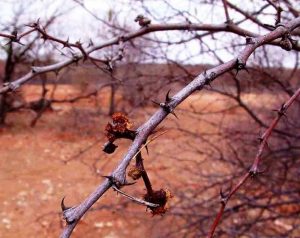
Acacia senegal var. leiorhachis. Photo: Bart Wursten. Source: Flora of Zimbabwe
Nearby we stopped at a species with 3 prickles at each node, two point up and one points down. This is A.senegal var. leiorhachis. Ross refers to its distinctive shape – “a slender spindly tree with irregular straggling branches”. It is apparently common along the Beitbridge Road where the 8m tall trees arch over the surrounding vegetation. It also grows in the Zambezi Valley. Just this side of the access road, in the Acacia section, we found A.senegal var. rostrata. Rostrate means strongly beaked and refers to the apex of the seed pod. I thought the way the pod was pinched into a point over each seed was striking, but the books do not refer to this so it may be peculiar to this specimen. This subspecies grows with Sesamnothemnus beyond Messina and in amongst the strange vegetation of the Tuli Circle.
The group then headed out to compare the straight thorned A.sieberiana var. woodii and A.abyssinica. Both have fairly fine leaflets, but A.sieberiana are larger. Codd states that A.abyssinica is related to A.rehmanniana both have an elongate leaf but the epidermis on the twigs of A.abyssinica does not fall away to reveal a red inner bark as occurs in A.rehmanniana.
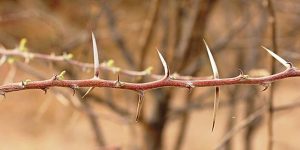
Acacia luederitzii var. luederitzii. Photo: Bart Wursten. Source: Flora of Zimbabwe
On the St. George’s side of the road is A.luederitzii var. luederitzii with small leaflets and both pairs of straight as well as pairs of hooked stipules on the same tree. Our local variety does not develop swollen spines like the other variety. I was so sure I had seen the other variety in the Gardens but could not find it recently. Tom then showed off his specimens of A.drepandobium, the most famous of the “antgall” species and one that I had never seen before. In this species most of the paired spines are fairly whorled and slightly recurved, but every now and then the base of a pair of spines is swollen into a deep purple coloured sphere the size of a marshmallow. Some had developed recently and these were still soft. The spines that stick out of the top and are longer than the normal spines, resembling cow’s horns. The leaf sprouts out of the centre of the gall. In the wild these galls are occupied by ants. In Kenya Hocking discovered that less than 1% of the trees did not have ants in the galls. The term gall usually refers to a strange growth induced by an insect, but in this case swelling is not induced by an insect and so the term is not entirely appropriate although it is commonly used. The ants simply move into the gall and once it is made and then are able to raise their brood in an ideal environment. Most Acacia species have nectar glands on the rachis and petiole and these glands on Tom’s A.drepandobium had each exuded a drop of teransparent, viscous fluid, presumably nectar. Hacking belieed that the ants protect the tree from herbivores, apparently the tree also benefits as birds and monkeys that could feed both the leaves and the ants prefer the ants and eat them instead of the leaves. He also suggests that the ants prune the axillery buds which he feels may help the tree survive dry conditions better. This seems to contradict Ross’ idea that some Acacia species produce bunches of leaves in the leaf axils without making new branches. This then saves energy, particularly in unfavourable, drought, seasons, or early in the growth season. This seems to be more characteristic of the species with long spines. The ant relationship is far from explained.
The group then re-examined A.gerrardii with “young branchlets mostly sparingly to densely grey pubescent, seldom glabrous or almost so epidermis usually splitting or flaking to reveal a rusty red inner bark.” A.karroo was compared with A.erioloba where the leaflets are longer and narrower. In the heights of one of the trees was a shrikes pantry that included a large gen locust. A.albida is often recognized by its grey green colour and then, near the pond is A.tortillis with a strange combination of hooked and long thorns sometimes both in the same pair.
Right next to the car park is A.hebaclada subsp. chobiensis in full flower. This bushy tree often gives off an overpowering small of Acacia, and is most noticeable in early evening. Tom grew it from seed collected from the Okavango in 1975, planted in 1978. It grows along the Zambezi above Victoria Falls and is often partly submerged. Ross describes the bark as pubescent whitewashed over a purple background and splitting but not rusty red. In this specimen there are actually a number of rusty splits but then no clue works every time.
Yet another interesting walk. Thank you Tom
-Kim ST.J.Damstra
OUTING BEYOND MUKUMBI MISION – SUNDAY 17TH AUGUST 1986
I suspect that more than a couple of people had heir misgivings about proceeding into Communal Lands in search of trees when our bus entered Chinamora, for the area closest to Harare is the most densely populated and most cultivated. However, the further we drove from town the better the woodlands looked until we arrived at our destination beyond Mukumbi Mission where most people were very pleasantly surprised at the fine state of the woodlands, even though some gully erosion was seen.
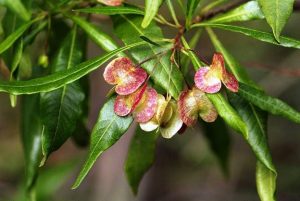
Dodonaea viscosa. Photo: Bart Wursten. Source: Flora of Zimbabwe
Just off the road was a good example of Monotes glaber the extra floral nectar showing as a lack dot. Dodonaea viscosa was full of 3-winged fruit and the upright posture of the narrow leaves was seen.
Along the stream and nearby we compared very distinct specimens of Syzygium cordatum and S.quineense. The first really belongs on stream banks, “cordatum” refers to the leaf base having a heart shaped appearance. This coupled with a near absence of a petiole, means that the stem is often surrounded by the leaf bases of the opposite leaves. The different appearance of S.quineense was readily apparent. One similarity was checked for and proved positive. This is that the veins do not extend as far as the margin but meet up slightly short of the margin an form a marginal vein. The same also applies to Faurea saligna seen close by. No confusion results though if one recalls that Faurea is not opposite leafed. Two distinct forms of F.saligna were noted. The one on the river had noticeably broader leaves, probably making it subsp. No. 1 mentioned in Trees of Southern Africa. The other seen away from the river had the typical narrow leaves of the wood lands form.
In the woodland away from the river I embarrassed myself by calling Dichrostachys cinerea an acacia until one of my flock discreetly pointed out that it had the beginnings of the distinct curly pod of the former.
Some of the trees were identified without their leaves. Lannea discolor had the fat ‘finger tip’ at the ends of the branchlets which earned it the name E.T.fingers of late. Burkea africana had the russet velvety growing points and Elephantorrhiza goetzei still had the remains of the edges of its pod hanging in tendrils as a dead give away. The”zig zag” branching of Euphorbia matabelensis, which was very common, gave that tree away.
Pseudolachnostylis maprouneifolia and Flacourtia indica were turning their own special shades of red to assist members with identification.
In amongst numerous old stand bys in the woodland area were examples of both Rhoicissus revoilii and R.tridentata. The “fruit” on the latter was shown to be a gall and much larger than the true fruit. The serrated margins of the R.tridentata were compared with the almost entire margins of R.revoilii.
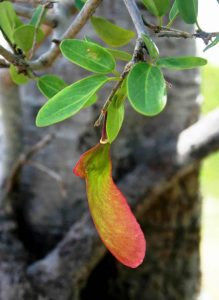
Securidaca longepedunculata. Photo: Bart Wusten. Source: Flora of Zimbabwe
Up among the broken up rocks on the slopes of the dwala we climbed up were some interesting finds, perhaps the most spectacular being the Securidaca longepedunculata which was of such a size that it had most of us guessing until the characteristic pods were perceived. Also in the size category was Margaritaria discoidea as an enormous shrub, and although all the leaves were dead and dry in appearance, one could still discern the “curled under” leaf margin.
The afternoon walk, also along a stream and then up a kopje also yielded much of interest. A dry scrawny specimen of Heteromorpha trifoliata was nonetheless crowned with its “starburst” seed heads. Having extracted seeds from caraway a week previously at Ewanrigg herb garden, I decided to try this tree and the result was a strong carrot taste. I now look forward to someone making a Heteromorpha seed covered loaf.
Up on the kopje behind the river were some special finds starting with a large Turraea nilotica in flower, but quite leafless. Not far off was a very large Monotes engleri with a trunk about 2-3 feet in diameter. Unlike M.glaber seen earlier, the leaves on this are dark above and pale below very like Parinari curatellifolia with which it can easily be confused.
On the descent keen eyes were rewarded to the right with an Abizia tanganyicensis which although without leaves was still distinguishable from say Sterculia by the typical flower buds.
A wonderful day was completed by a scenic ride across to the Shamva road passing rock outcrops adorned with Aloe excela in flower. We thank Molly Kilpert and Fr. Hugh Ross for their splendid recce efforts.
-P.Haxen
We would like to round off on a serious note and remind over enthusiastic plant collectors to have a care when collecting especially when doing so in the presence of Communal land dwellers. It is easy to succumb to temptations especially if one judges that it will not dent the ecology, but there are other good reasons for resisting the temptation and the showing an example, is perhaps the most compelling one. You could also be committing a criminal offence if you are taking a Specially Protected Plant. We thank the member who plucked up the courage to write in to prick our collective conscience.
ROOTNOTE: The Committee has received a letter from a member enquiring what it is dong about the preservation of the indigenous woody vegetation and the establishment of arboreta in Zimbabwe.
In the next Tree Life we shall give a short account of the history of two particular projects. Firstly the efforts made by the Tree Society members at the Arboretum at Lake MacIlwaine to create contour paths and thus open up the bush so that individual trees might grow bigger, a special tree reservation. This area is now contained within the Lake MacIlwaine National Park. Secondly, in the case of Binga we will outline efforts made by a few dedicated people to eradicate the Mauritius thorn which would have shortly enveloped and destroyed the swamp forest.
Anyone who would care to comment on these subjects is invited to write to the Committee, preferably before the next Tree Life is due to be compiled about September 19th.
ROOT NOTE: Mrs.Claire Cullinan of Xanadu Estate, Bromley has asked why the spring colours on the musasa, Brachystegia speciformis, are so vastly different on groups of trees growing on exactly the same type of soil and under the same weather conditions. Before answering that question perhaps we should analyze the colours themselves. Leaves are usually green in colour due to the pigment chlorophyll that is able to capture the energy in red light and use it to convert water and carbon dioxide into sugar. Plants exposed to bright sunlight often protect the chlorophyll by producing a red pigment, anthocyanin. This is most clearly seen in many of the succulents that are right red when kept in full sunlight. If moved into the shade the plants stop making anthocyanins and the leaves become green. New leaves may also benefit from the protection of the anthocyanin pigments and so a number of plants produce bright red young leaves, and these include the musasa. As everyone knows the leaves start of bright scarlet or deep red and then change colour to orange, gradually more green is added until the leaves are apple green. They then deepen to dark green. This provides the first half of the answer – different trees start to flush on different days and so they are all at a different stage of development at any one particular time. Why are they staggered – it’s simply a genetic difference. Jack and Judy Reid observed that one particular tree would flush at the same time every year. We may well ask why they don’t flush all together. Well there are advantages to flushing early and advantages to flushing late. Trees that flush too early may be caught out by a late frost that damages the spring leaves. At present the large Milicia excela on the lawn opposite the pond in the Gardens has been frosted in this way. Bu trees that flush too late may lose out on valuable time required to ripen their fruit or to trap more energy to grow more. As the seasons vary, so the optimum strategy must vary, some years the early flushing trees benefit. Other years they are frosted and late flushing trees benefit. The second point is that the amount of anthocyanin each tree produces varies, just as the amount of brown pigment in our eyes varies from individual to individual. This is also controlled genetically. These two factors combine to produce the splendid array of colours which excites us all so much during August and September.
-Kim ST.J.Damstra
KIM DAMSTRA CHAIRMAN


